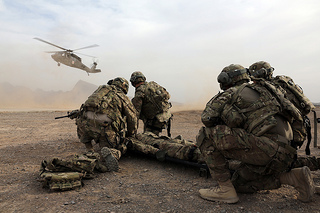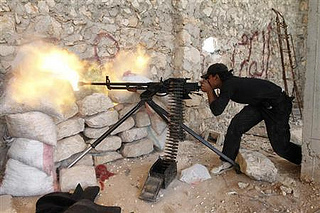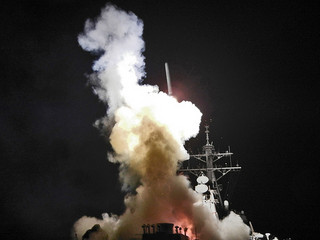Obama's Five Options In Syria
The Syrian conflict is reaching critical mass. Reports of chemical weapons use by the Syrian government is forcing regional and global leaders, including the United States, to act. The UK parliament just gave an emphatic no to Prime Minister David Cameron's proposal for military intervention. Lines of varying color have been drawn and naval ships are on standby.
Oh, and Russia is being Russia.
So what are President Obama's options? We count them down and the odds that they'll happen:
Option #5: Full Ground Invasion
In case you had forgotten, America has gone down this road recently with mixed results. Twice in the last 12 years, as a matter of fact.
While the merits of the wars in Iraq and Afghanistan can be debated on another day, American public opinion is pointing to a general wariness for another drawn-out conflict, U.S. casualties, obscene military spending and "nation rebuilding."
President Obama seems to understand this, the White House having previously ruled out U.S. troops on the ground. There are those, however, who are pushing for putting boots on the ground, particularly special operations forces (SOF).
In an August 27 article for The Daily Beast, former Special Forces officer Andrew Slater argued that airpower alone won't get rid of the Assad regime because the conflict is deeply fragmented and Syrian forces are located in densely populated areas, so air strikes could result in massive civilian casualties.
Odds: 6570/1. The odds of another ground invasion of a Middle Eastern country are about the same as the combined number of U.S. casualties in Iraq and Afghanistan. Not this time.
Option #4: Do Nothing
You'd be hard-pressed to find this much pre-war drum beating without it being followed up with some kind military action. Sure, the Obama administration could follow the U.K.'s path and do nothing, but that's very, very unlikely.
The Obama Administration has set numerous ultimatums and red lines regarding Syria's use of chemical weapons. John Kerry just went on television and said that the U.S. had to act.
Odds: 1000/1. The "do nothing" approach wouldn't be by choice - as we saw yesterday with Prime Minister David Cameron's intervention proposal being rejected by the UK parliament - and the same goes for Obama. Only a formal congressional rejection could make this happen.
Option #3: NATO-Imposed Ceasefire
This option should probably be classified as the Best Possible Option That Will Almost Certainly Be Ignored By Everyone. As UC Irvine professor Marc LeVine argued in his opinion piece today for Al Jazeera, there is precedent for a NATO-imposed ceasefire. According to LeVine, not only would it allow for UN inspectors to finish their work, but it could provide a real opportunity for negotiations with Russia, the UN, the Arab League and others.
As LeVine points out:
An imposed ceasefire would not merely stop the fighting. By freezing the conflict without prejudicing a final outcome, it could allow for the creation of humanitarian corridors, damage assessment across the country, discussions on how to stem the tide of refugees, return people to habitate areas not under immediate contention, and install peacekeeping forces.
Odds: 10,000/1. This type of thoughtful, informed, rational analysis to a quickly-escalating conflict is almost always ignored. Bet on it being ignored this time, too.
Option #2: Arm The Rebels
The U.S. is supposed to be doing this already, according to White House spokesman Jay Carney who stated July 23 that "the goal of the military aid expected to include small arms, ammunition and perhaps anti-tank weapons is to keep the Syrian opposition going against forces aligned with President Bashar al-Assad's regime."
While arming the rebels sounds like a relatively legitimate option, a few problems remain. First, reports out of Syrian rebel camps indicate that the U.S. hasn't quite gotten the promised weapons to the rebels. Second, there's little indication that arming the rebels, even with anti-tank weapons, could turn the tide against Assad's growing momentum.
Third, the U.S. has armed rebel groups before. Unfortunately, it doesn't always work out as intended.
Odds: 1/2. Obama and Congress already approved a plan in June to arm the Syrian rebels. Some small weapons have already been received by Syrian rebel forces. Apparently, there are serious obstacles and it's unclear that this will do anything to stop Assad.
Option #1: Air Assault
This seems to be the expected and accepted next step for the U.S. against Syria. Every major news source from NPR to BBC seems to have accepted that the U.S. military will strike in the next few days, most likely with cruise missiles launched from Navy destroyers in the eastern Mediterranean.
Even within the pro-air assault camp, there's differing opinions as to the scope of said assault and desired result, including everything from "the initial military option would be fast" to "this is a warning shot to Assad" to "this won't tip the balance inside Syria or drive Bashar al-Assad from power."
Odds: 1/1. As almost every report indicates, this would be the Obama administration's next move in the Syria conflict. Proponents point to the relative ease of air strikes, the ability to prevent U.S. casualties that a ground invasion would incur, and the precedent set by American/NATO intervention in the former Yugoslavia and, more recently, in Libya in 2011.
Also, air strikes make for great night liveshots for CNN.
Reach Executive Producer Colin Hale here. Follow him on here.



